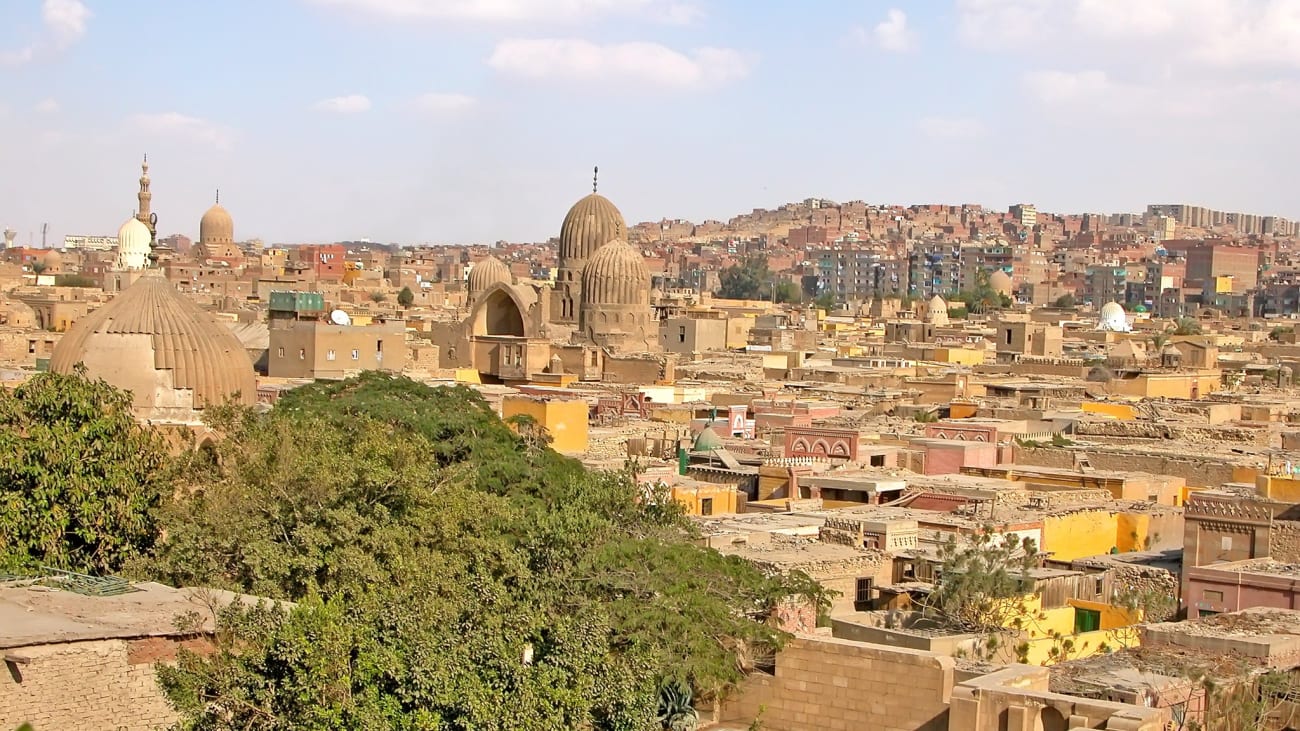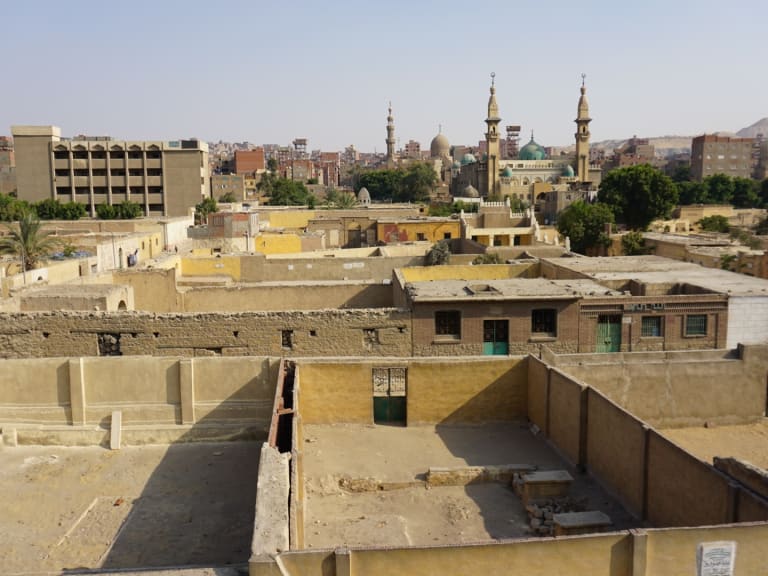10 Best Things to Do in City of the Dead (Cairo)
The ornate domes, the views from the minarets and the walks through the historic streets of Cairo's City of the Dead are unparalleled.

City of the Dead, Cairo | ©Dennis Jarvis
The City of the Dead is an Arab necropolis located in south-east Cairo. As it has a network of tombs and mausoleums, it is known as "el'arafa", which means "the cemetery". Along with a tour of the Pyramids of Giza, the City of the Dead is one of the places you must see during your stay in Cairo.
You can take a quick taxi ride from the city centre to the Qait Beh Mosque, which costs approximately £3.50, an excellent starting point for your journey through the City of the Dead. The Koranic calligraphy and divine symbols in Arabic within the complex are inspiring. If you have some extra change in your pocket, I would recommend paying a tip to the caretaker so you can climb the minaret. The views from the minaret are unrivalled in Cairo.
1. Sign up for a guided tour of the City of the Dead

Stroll through the streets of the City of the Dead in the company of a qualified Egyptologist guide as you head north to see the highlights of this immense necropolis. The advantage of choosing a tour is that you can travel in comfort with a private transfer from your hotel to the City of the Dead and back (air-conditioned minivan transport).
What's more, as it's a fairly rural area, you'll appreciate having someone who knows the place inside out. The tours cost approximately £30 and last an average of 4 hours.
This necropolis has become as popular as any other major destination in the Egyptian capital, so don't be afraid to ask for every detail and wander freely from the start of the tour to its conclusion. However, it is advisable to go during the day to appreciate every corner in detail.
On these tours of the City of the Dead, you will explore the small squares where children play football, very close to historic tombs. You will also walk through the narrow passageways that lead to the different mosques. Believe me, the atmosphere in these narrow streets is iconic.
Many events are also organised in this area. You can check the following Facebook page to see upcoming events.
2. Pay tribute to the heroic Egyptians at the Northern Cemeteries

Don't forget to pay your respects to the Egyptians who fell in the 1967 War against Israel, just south of the Amir Qurqumas Mosque. Here you will find many disorderly gravestones in a heroic style, recognising the brave Egyptians. This area tends to be busier with tourists and locals, so you can also take the opportunity to ask questions and enjoy a collective experience.
If circumstances and time allow, take some time to talk to the locals, many of whom speak decent English. You are sure to hear inspiring stories of family and patriotic love. You can also meet the people who work in the City of the Dead, which is full of shops and craft workshops. After all, it is the impressions and memories of the people that you will take with you everywhere. Most of the locals speak English very well, especially the younger ones.
3. Attend a concert or cultural event

When there is an event or concert at MASQ (Maqad Sultan Qaitbai; a free entertainment association offering theatre and dance performances), the place fills with Egyptian hipsters, artistic expats and architecture enthusiasts.
Just as the spacious reception hall welcomed Mamluk royalty in its day, today it welcomes any kind of performance, from modern art exhibitions to lively music concerts. These cultural events are usually organised by MASQ. Check out the MASQ Facebook page for more information.
If you are visiting Cairo in earlyNovember, I recommend the D-CAF, the annual contemporary art festival, which hosts fairs focused on local artisans. There are also presentations of works by contemporary artists, walking tours and music festivals.
These events play a crucial role, as by putting historic buildings to practical use, they ensure that the structures remain in good condition and are not abandoned. Residents also benefit from social development programmes. And it all helps to slowly remove the stigma surrounding the City of the Dead, which many tourists are afraid to visit.
4. Visit the mausoleum of Munkalibugha al-Fakhri
The domes of the mausoleum are a unique feature of the complex.

The once glorious Mamluk tomb, built in the 1340s, shows touches of magnificence and glorious details despite some crumbling walls.
The mausoleum once served as a two-storey residence with beautiful inscriptions on the stairs and ceiling. While it is true that it is not in the best condition it could be, it still displays Ottoman tombstones, colourful tiles and stone inscriptions.
5. Explore the street art and murals

There is more to the City of the Dead than the historical monuments of its magnificent past. There is also some wonderful graffiti.
Murals burst with life from unexpected corners to bring joy and colour to the neighbourhood. There's a smiling mouse with the word ahlan (welcome) painted on a corner of Salah Salem Highway that draws you into the mysterious streets of the City of the Dead.
Once inside, and around the Maq'ad, and further down Souq Street, there are more ingenious depictions of this mouse: holding a cat by the chain or running away from an unravelling mummy. The mouse is an original creation by Polish artist Franek Mysza, who first came to the City of the Dead for an art project.
In the City of the Dead, Mysza began painting some private houses (with the owners' permission). Many residents were sceptical at first, but once the mouse began to gain attention, others wanted to join this artistic trend.
6. Walk down Souq Street

This street has several domes carved into some buildings, recalling the glorious era of Qaitbey's reign. Mysza's mouse can be found in some side streets. There is also a mural depicting an ancient Egyptian king alongside graffiti of football star Mohammed Salah. The narrow street opens onto a wider square with a vibrant vegetable market and a kiosk laden with soft drinks.
Walk down El Souq Street and you will see an arch carved with the intricate detail typical of Mamluk architecture, which reaches its peak in the modern apartment blocks.
There is a mural of the Kaaba decorating a house, showing that its residents have been to Mecca. Potted plants line the doorways, and there are a couple of small shisha cafes. You can also see Mamluk domes or tombstones from the street itself.
7. Visit the Faraj ibn Barquq complex

Don't forget to visit the Faraj ibn Barquq complex with its beautiful mosque and leafy courtyard.The security guard can act as your guide, or you can go in and explore on your own.
The vast courtyard features two chevron-carved stone domes. One of the largest monuments of the Mamluk period in Burgi, the complex dates from 1400-1411 AD. Sultan Faraj built the complex as a tribute to his father, Sultan Barquq.
The complex marks one of the first signs of urbanisation in what was then just a vast desert. The complex also includes baths, grain mills and water wheels.
8. Buy some glassware

The City of the Dead is known for its glassblowers, and here you will find several workshops selling everything from vases and drinking cups to Christmas decorations in Cairo. It is worth noting that these artisans are very flexible and professional when it comes to creating pieces, so if you can get them to understand your idea, it will only be a matter of minutes before you see it come to life.
9. Spend Ramadan in the City of the Dead

Ramadan, with its festivities full of lights and food, is an *incredible time to explore this necropolis. A variety of events are often organised during the holiday, from Egyptian folk dances to tanoura (a traditional dance) **performances **and theatrical performances.
If you are looking to enjoy the nightlife in the Egyptian capital, and specifically in the City of the Dead, you should consider coming during Ramadan.
10. Visit the Amir Qurqumas Mosque and the Sultan Inal Funerary Complex

If your appetite for Mamluk architecture has not been satisfied by your stroll through the streets of the City of the Dead, head further north to enjoy two of the most highly praised buildings: the Amir Qurqumas Mosque and the Sultan Inal Funerary Complex.
The beautiful arabesque design carved in stone and the opportunity to discover the site on your own are all part of the experience. These complexes not only had mosques and tombs associated with them, but also markets, residences and construction workshops for the maintenance of the architectural structure, details that you will appreciate as soon as you arrive in the area.
What is the City of the Dead in Cairo like?

People have always lived in this City of the Dead. And today, there is not much difference between this area and other districts of Cairo. There are tall apartment blocks, vegetable markets, schools and cafés.
However, there is an atmosphere in the City of the Dead that you will not find anywhere else. It is a quiet place compared to most of Cairo. The narrow, unpaved streets mean less traffic and noise.
And although some companies offer walking tours, the City of the Dead is still largely unexplored by tourists. There are no souvenir shops or aggressive vendors promising great deals; however, it is full of treasures you won't find in the modern suburbs of the city. Some are lovingly restored, while others lie in heartbreaking neglect.
The area contains some 30 Mamluk monuments, which are UNESCO World Heritage Sites. It also includes many 19th-century Ottoman tombs of great historical value.
The City of the Dead is an unspoilt part of the city. It is also a place that defies stereotypes, with a clear intellectual mix, from university graduates and people who speak English fluently to people who are illiterate or have never received any schooling.
A brief history of the mysterious City of the Dead

The City of the Dead was founded by Amr ibn al-As, who led the Arab conquest of Egypt in 642 AD. At first, the necropolis was only inhabited by Sufi mystics. The Fatimid Caliphate saw the City of the Dead as a place of pilgrimage. Later Mamluk sultans held military parades, religious celebrations and processions, while building their palaces on the main roads of the cemetery. During the Ottoman era, the necropolis was dotted with Sufi colleges and madrasas.
